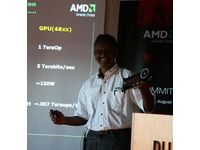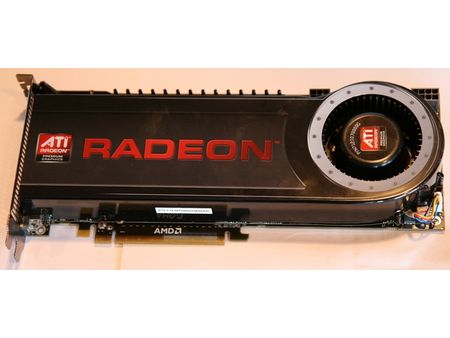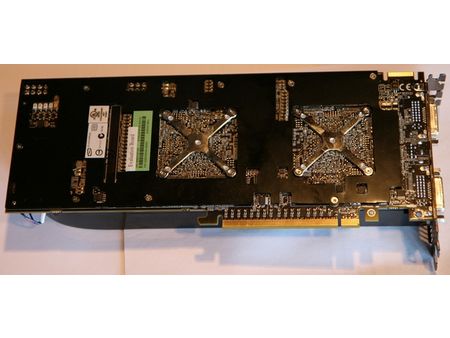AMD's Radeon HD 4870 X2: R700 First-Look
Two Times The Compute Power
Although AMD took the hardware community by surprise with the performance of RV770 and the derivative Radeon HD 4850/4870, things didn’t go entirely according to plan. The company launched its boards immediately after Nvidia, which turned around and slashed the prices on its own models, determined to win this round of the ongoing graphics card war.
And yet, a month and a half after the launch of AMD’s newest round of products, the verdict hasn’t changed. Neither the GeForce GTX 260 nor the GeForce 9800 GTX+ (only recently made available) can take on the Radeon HD 4870 with regards to price or performance, even in light of heavy cuts from Nvidia.
But AMD’s not out just to make waves with the gamers looking for value. It also wants to reclaim a crown it lost a long time ago to Nvidia’s last two generations of large, monolithic programmable graphics architectures. As a means to that end, the company is putting a pair of its most impressive GPUs on a single PCB and calling it the Radeon HD 4870 X2. Now the question remains: does the new board have the muscle to take on Nvidia’s GeForce GTX 280, the single fastest card?
The Radeon HD 4870 X2
Contrary to what its code name might otherwise suggest, the R700 actually centers on a design sporting two RV770 GPUs. Thus, the Radeon HD 4870 X2 finds itself in a very high-end segment of the discrete graphics market. However, in the next few weeks you will also be able to find a Radeon HD 4850 X2, based on the same two chips but with lower frequencies and likely less memory as well.
In appearance, the Radeon HD 4870 X2 remains similar to the Radeon HD 3870 X2. However, looks can be deceiving, as we will soon see. Not surprisingly, the card itself is quite long (26.7 cm). It sports a large blower that exhausts through the back of the board and is neighbored by two dual-link DVI outputs (neither HDMI nor DisplayPort connectivity are native to the back panel). The board requires two auxiliary power connectors—one with six pins and another with eight (PCI Express 2.0-compliant). The two GPUs are positioned on the same PCB, though you won’t see them since a heatsink/fan combination covers the entire board.
This card, like it’s bi-GPU flagship predecessor, must deal with sharing its frame buffer. But contrary to CPUs and their more complex memory management techniques, these things evolve a lot more slowly in the graphics card world. By comparison, all of the bi-GPU cards up until now were similar to the Pentium D 900 (Presler), acting as an assembly of two cores functioning independently and integrating their own local memory (L2 cache for the CPU, frame buffer for the GPU). All of the graphics data is thus duplicated between the two cards. Communication between them passes through an external bus—think FSB for Intel’s Pentium D and PCI Express for these graphics cards.
Get Tom's Hardware's best news and in-depth reviews, straight to your inbox.
As with the Radeon HD 3870 X2, a PCI Express bridge manages the communications between the two GPUs and the chipset. Once the final display outputs is calculated, each GPU sends them to another chip that assembles the result according to whichever multi-card rending technology is used (AFR, most often) and then sends it all to the monitor. Back when we tested the Radeon HD 3870 X2, we found that the biggest impact on performance was attributable to the board’s memory capacity, since memory on a bi-GPU card has to be divided in two. And in order to assure adequate performance, you often have to multiply the quantity of memory by four, which is what AMD does with the 4870 X2.
Current page: Two Times The Compute Power
Next Page A Secret Weapon Exposed: Specs-
tipmen Good job ATI/AMD! really good card you have here lets hope its cheaper then the GTX 280. I'm glad i waited it out now i can replace my old setup. Now i will get new X48 board and 2 of these puppys and im sure I need a better power supply I don't think a 750 watt will do it.Reply -
Whoa, what happened to the heat and power consumption level charts? Where they that far off the scale you dare not show them? The card performs nicely but this is ATI/AMD we are talking about, they love heat and power. So what are they?Reply
-
Cmhone It says at the end of the article their power meter went kaput, and also not to expect much in the power consumption department anyways.Reply -
neiroatopelcc Someone explain to me what this means in english?Reply
"Back when we tested the Radeon HD 3870 X2, we found that the biggest impact on performance was attributable to the board’s memory capacity, since memory on a bi-GPU card has to be divided in two. And in order to assure adequate performance, you often have to multiply the quantity of memory by four, which is what AMD does with the 4870 X2." from page 1 -
It's nice to see AMD/ATI challange nVidia again, it's been too long nVidias market. My take is that this situation can only benefit the consumers; push for faster GPU's to more affordable prices. It will be interesting to see nVidias run to retake the performance as well as the midrange price/performance crown.Reply
-
randomizer neiroatopelccSomeone explain to me what this means in english? "Back when we tested the Radeon HD 3870 X2, we found that the biggest impact on performance was attributable to the board’s memory capacity, since memory on a bi-GPU card has to be divided in two. And in order to assure adequate performance, you often have to multiply the quantity of memory by four, which is what AMD does with the 4870 X2." from page 1The HD3870X2 had only 2x512MB memory, and each GPU could only access 512MB, which held its performance back. Although I think it should say "doubled", not "quadrupled", since the HD4870X2 has 2x1GB.Reply
-
Thurin .............................Reply
Point 1:
It's great that Ati is putting up a fight and it's obvious that with all fan-boys and trash talking/flaming aside the only reason why this rapid progression on a pure processing and on the overall technological level is made possible through competition between the titans of the graphics processing world.
.............................
BUT!
According to other valued/trustworthy sources the 4870 X2 manages only a 1.09 over 1.00 increase in performance.
see link:
http://tweakers.net/reviews/957/4/his-radeon-hd-4870-x2-versus-asus-geforce-gtx-280-pagina-4.html (Copy paste the link if needed)
.............................
As for the significant increase stated in this article, it's great, but only applicable to those games with integrated support for crossfire technology. (Further and extensive testing would be desirable, and posting actual facts to support claims would also be duly noted. // I know some testing has been done, but a full review on exactly what value is added with the new card, still remains to be seen.)
.............................
Point 2:
As for NVidia's reply to the 4870 X2 dual-gpu card is the introduction of the 65 nm -> 55nm gpu chipsize reduction.
Link:
http://tweakers.net/nieuws/55050/introductie-55nm-versie-geforce-gtx-280-eind-augustus.html
According to the news this is to take place at the end of August. meaning that the reply is ready and launched by the end of THIS month.
.............................
I would like to at this point state I'm not a fan boy for either side, and I myself have switched from Nvidia to Ati back to Nvidia and will keep doing this as either side dominates the market with high quality merchandise and depending on which one is the market leader at the points where I update my machines.
.............................
My apologies to those of you who cannot read or understand Dutch.
Here is a substitute link for the interested English parties:
http://www.stokedgamer.com/2008/07/nvidia-geforce-gtx-290-launching-at.html
The reason I responded with such diligence and ferocity is not because I hate Tomshardware, think that Ati is doing a bad job or that NVidia rocks beyond compare... The reason for my reply is that I wish for the consumer to be fully informed and not end up buying a more expensive product for less bang/buck than originally expected.
Stay informed folks ! (For those of you who have a no limit budget the 4870 X2 might be the way to go, other than that, if you are looking for a more financially affordable card, wait for the 55nm NVidia GTX280 revision (name is yet to be determined, release expected at the end of the month))
That concludes my rant for the day and I hope you guys are now fully informed or that I have at least have sparked your interest on the field of gathering information before drawing a conclusion based on a single review ;)
Look around! and stay informed ! Ati and Nvidia both rock and the best of luck to both companies... may the struggle be eternal and the progress fiery and extreme!
.............................
-= Michael Out =-


